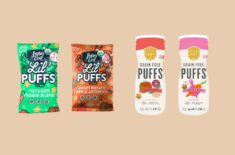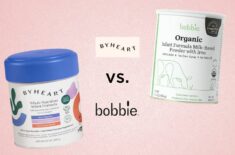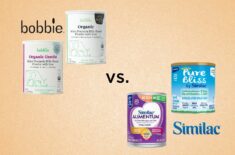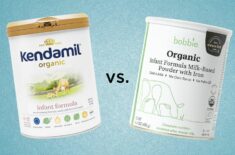Overview
Starting solids can be one of the most exciting milestones your baby and you experience in their first year. But which feeding approach should you choose: BLW (baby-led weaning) or spoon-feeding purées?
BLW pioneer Dr. Gill Rapley advocates the approach because it can offer the following benefits:
- Promotes independence
- Helps improve fine motor skills
- Less picky eating
- Easier family mealtimes
- Sensory development
Many parents also choose purées and spoon-feeding because of these possible advantages:
- Less messy mealtimes
- Less food waste
- Easier feeding on the go (you can bring food jars around)
Still, both of these feeding methods also have some drawbacks. And you might be wondering whether you can do a combination approach to feeding your little one.
What are the disadvantages of baby-led weaning? At what age you can start feeding your little one solids, and which foods can you offer? Can you do baby-led weaning after purées, or if your child doesn’t have teeth yet? Find answers to these questions below.
Baby-Led Weaning Vs. Purées: Main Differences
Baby-Led Weaning Highlights
- Your child controls everything (food, pace, amount, etc.)
- Your child learns to eat finger foods from the start
- They can try purées, but it’s not a requirement (but you can’t feed it to them with a spoon)
- Your baby joins family meals
- You respect your child’s satiety cues and don’t push them to eat more or eat specific foods from what’s served.
Traditional Weaning (Purées) Highlights
- You get to pick almost everything
- You start with purées and gradually introduce finger foods
- Baby can eat anytime
- You feed your child with a spoon (for less messy mealtimes)
Learn more about each feeding method below.
Baby-Led Weaning
BLW is a feeding approach that lets your baby lead in everything:
- Choosing what food to eat (from the options you prepared)
- Eating at their own pace
- Eating as much or as little as they want
- Eating the way they want
Although you can help pick your child’s options, you’re not allowed to “help” them choose what they should eat.
BLW Procedure
- Check for your child’s readiness to eat solid foods.
- Educate yourself about the BLW approach, such as dos and don’ts, first foods, etc.
- Learn how to tell the difference between the gag reflex and choking.
- Time your baby’s feeding with family meals.
- Secure your baby in a high chair with a footrest.
- Choose healthy foods. It may be best to provide different textures but always check for choking hazards.
- Prepare pieces of food appropriate for their age.
- You can put the food on your baby’s highchair tray or in a bowl. But always ensure to clean the food tray before and after each meal.
- Let your baby lead.
- You can encourage them while eating, but don’t try to sneak in some food in their mouth.
When Should You Start Baby-Led Weaning?
Dr. Rapley recommends waiting until your child is six months old before starting them on baby-led weaning.
But she also acknowledges that kids develop at different rates. So, some might be ready by four months of age. (1)
How Do I Know When My Baby Is Ready For BLW?
No matter what feeding approach you pick, you can check for these signs of readiness before starting your child on solid foods:
- They can already sit on their own, with or without hip support
- They exhibit neck strength (can control head)
- They show interest in food (tries to grab food, leans forward, opens their mouth, etc.)
- They can swallow or move food to their throat
- They don’t automatically push their tongue forward when something is put in their mouth (tongue-thrust reflex)
The signs of food readiness can also be signs that your child’s digestive system is ready to process solids. (1)
Dr. Rapley warns that starting too early can cause problems with baby-led weaning.
For example, some parents might think their baby “failed” in BLW because they don’t show interest in food. But the reality is that their child just wasn’t ready to eat.
She explains that if your child didn’t manage to put food in their mouth despite trying, you shouldn’t view it as a failure.
But you can’t also “help” your child learn how to eat by guiding their hand to their mouth because that can be dangerous.
A child who isn’t ready can have a higher risk of choking, even on puréed foods.
Are There Any Benefits To Baby-Led Weaning?
- May save you time and money
- No need to transition to another feeding style
- Encourages fine motor skills
- Less picky eating
- Better acceptance of food varieties and textures
- Easier family mealtimes
- Promotes social skills
- Sensory development
- No need to coax your baby to eat
What Are The Disadvantages Of Baby-Led Weaning?
- Personal concerns over gagging and choking
- Uncertainty over how much food baby is eating
- Messy mealtimes
- More food waste (sometimes your baby might just play with the food)
- Food allergy identification problem (if you introduce several foods at the same time)
- Longer mealtimes
- Judgment from other people who don’t understand BLW
- May take time to introduce certain foods (ex. because your baby doesn’t have teeth yet)
Is Baby-Led Weaning Recommended By Doctors?
Pediatricians’ opinions may be divided over baby-led weaning.
Dr. Wendi Carlton, a physician based in Arizona, explains that BLW can promote healthy eating habits. (2)
She explains:
“You give them a chance to have food in front of them that they can touch, feel, smell, and know the texture in their mouths. Some kids have texture aversions growing up and this may be because you’re not letting them experience textures on their own early enough.” (2)
Ohio-based pediatrician Kimberly Churbock assures parents that children can still get proper nutrition on BLW. She adds that BLW is a complementary feeding method, so you continue providing formula or breast milk feeds. (3)
Both health professionals recommend talking to your child’s pediatrician before starting BLW. They advocate picking safe foods and watching your children during mealtimes.
But some pediatricians don’t agree.
One study showed that only 41.9% of healthcare professionals were aware of this approach. (4)(5)
The doctors in this New Zealand-based study refused to recommend BLW over concerns about choking and suffocation because they didn’t have first-hand experience or training in this approach.
But they acknowledged these possible BLW benefits:
- Greater opportunity for shared family mealtimes
- Fewer mealtime battles
- Healthier eating habits
- Convenience (no need to prepare different meals for your baby and the rest of the family)
- Possible developmental advantages
Surprisingly, even if around 81.8% of Canadian healthcare professionals knew about this feeding method, only 48.5% might recommend it. (6)
Still, they acknowledged that BLW could promote:
- Fine motor skills
- Oral development
Challenges Of BLW
Meeting Nutrient Requirements, Especially Iron
Your child picks the food they want in BLW. So, they can miss out on certain nutrients because they favor other options.
Also, some iron-rich foods like red meat (such as beef) can be too hard for your child to chew on when they’re younger and don’t have teeth yet.
But you can try to add the following iron-rich foods to your child’s options: (7)
- Red meat (such as beef, lamb, pork, goat, or venison)
- Seafood
- Poultry (chicken or turkey)
- Eggs
These foods are good sources of heme iron, the type of iron readily absorbed by human bodies.
Just ensure that you’re not serving half-cooked, raw, or still-tough meat to reduce the risks of choking and food-borne illnesses.
Your child can also get iron from plants:
- Dark green, leaf vegetables
- Green beans
- Lentils
- Tofu
These plant sources provide non-heme iron, a type of iron that’s less easily absorbed by the body.
Iron absorption can improve with vitamin C, so you can also add these to your child’s food options:
- Berries such as strawberries, raspberries, and blueberries
- Citrus fruits such as oranges and lemon
- Papaya
- Tomatoes
- Cabbage
- Broccoli
- Sweet potatoes
But always remember to cut and/or cook these foods to reduce the risk of choking.
You can also pick iron-fortified infant cereal, but only with your pediatrician’s approval. While these foods may be rich in iron, they can be loaded with added sugars. Hard cereals can also be a choking hazard to small children.
Growth Concerns (If Nutrient Needs Aren’t Met)
If your child refuses to eat these iron-rich foods, talk with your pediatrician. Your child might need to take iron supplements to avoid the risk of iron-deficiency anemia, a condition that can cause delayed growth and possible susceptibility to infections. (8)
You should also ensure you continue providing breastmilk or infant formula.
Possible Introduction To Junk Foods And Sugary Products
Some studies show that infants following the BLW approach may be exposed to junk foods and sugary products while sharing meals with the family. (4)
But Dr. Rapley points out that BLW is all about introducing healthy foods to your baby. If the rest of the family is actually giving your child some sugary treats and unhealthy snacks, then you aren’t really doing true BLW even if your baby is still the one feeding themselves. (9)
Still, even with spoon-fed infants, avoid highly processed foods with added sugars or unhealthy trans fats.
Even if given in smaller proportions, some family foods like pasta, cheese, sweet cookies, bread, and butter can lead to excessive weight gain, especially in young children. (4)
But if introduced to healthy, whole, organic foods with less sugary or fatty options (unhealthy fats), kids that follow baby-led weaning may have a reduced risk of obesity.
Can I Do Baby-Led Weaning After Purées?
Yes. Dr. Rapley believes it’s never too late to switch to BLW, even if your child has already started with purées. (9)
How to transition:
- Start slow
- Try self-feeding with purées
- Serve safe foods
You can still incorporate purées in baby-led weaning:
- Let them explore the food and self-feed with a baby-friendly silicone spoon.
- Instead of giving it to them in a spoon, you can put it in a small bowl and let them dip their fingers in to have some.
- You can also let them use purées as a dip for their finger foods.
Can You Do Baby-Led Weaning With No Teeth?
Yes. Teeth aren’t a requirement, but you’ll need to choose the right foods.
It’s best to start with soft options that their baby gums can manage. You can eventually introduce hard foods once they grow teeth. But always check for choking hazards.
How Safe Is Baby-Led Weaning?
Studies show that baby-led weaning can have the same risk of choking as traditional weaning with purées. (4)(5)(10)
But considering that as many as 35% of babies can choke at least once between ages six to eight months, it’s still important to be careful. Keep choking hazards from your baby’s food options. (10)
You can read more about this topic in our article on baby-led weaning safety.
Traditional Weaning (Purées)
Pros
- Cleaner mealtimes
- Less food waste
- Easier to monitor how much food your baby is eating
- Easier to feed your baby (no need to learn about BLW concepts)
- More convenient feeding on the go (you can bring food jars around)
Cons
- Feeding moves at your pace
- Time-consuming food preparation (for homemade purées)
- Cost and safety concerns over commercial purées
- Potentially more packaging waste (for commercial purées)
- Need to monitor baby food recalls (if you’re buying baby food purées)
- Need to transition to table foods
- Doesn’t encourage motor skills
- Fewer food varieties and textures
- May increase likelihood of picky eating
Challenges Of Purées And Spoon-Feeding
Difficulty Accepting New Textures
Your child might not be exposed to different tastes and textures with purées.
Because they’re used to smooth purées, some babies might have difficulty adjusting to new textures.
Some commercial food companies like Little Spoon and Yumi encourage you to give your child different flavors and textures. But BLW can offer more options in terms of these factors.
Need To Transition To Table Foods
Eventually, you’ll have to teach your child to move to family foods in spoon-feeding. But if you started with baby-led weaning, there’ll only be one training.
How Can I Get My Baby To Progress From Purées?
Typically, you start with smooth purées.
For example, choose either homemade or commercial purées that have a thinner consistency for beginners.
After starting with thinner purées, you can gradually choose thicker purées and slowly add a variety of textures and flavors.
You can also ask your pediatrician or a registered dietitian for advice on how you can feed your child by their age and developmental stage.
When Should I Stop Puréeing Baby Food?
Feeding methods aren’t a “one-size-fits-all” thing.
You can stop giving purées to your child at any age or when they refuse to eat them.
Many kids make their own schedules because they develop at different rates.
Still, if you have feeding concerns, consult your child’s pediatrician.
Are Purées Bad For Babies?
No. Purées remain a good choice for babies and may be preferred by many doctors.
Many healthcare professionals recommend purées, believing that it can be a safer choice because they might have a reduced risk of choking. (4)(5)
How Long Is Puréed Baby Food Good For?
It depends on the type of baby food and whether it’s homemade or commercially processed. But typically, puréed foods can last for around 24-48 hours in the fridge or 2-3 months in the freezer.
Still, check the label for the expiry dates and follow the manufacturer’s instructions in storing your baby’s food.
Also, double-check the food for signs of spoilage or discoloration.
Mix Method: Purées & Baby-Led Weaning
Pros
- Opportunities to self-feed
- Easier to determine how much your baby is eating
- Easier for child care
- Easier to offer food varieties
Cons
- Confusing mealtimes
- Time-consuming
- Not recommended by BLW pioneer, Dr. Rapley
Dr. Rapley supports parents’ freedom of choice to provide their children with a feeding approach that works for them and their baby. But she also cautions against doing a mix of BLW and purées unless you’re still letting your child do everything else on their own.
She explains that: (9)
“BLW is about more than just offering your baby food to pick up – it’s about trusting him to know what he needs. If you’re topping him up with a spoon after he’s had a go with his hands, then you’re not really doing that.
The bottom line is that trusting your baby and not quite trusting him are simply not compatible. So, while doing some self-feeding and some spoon feeding may work for you, it’s not BLW.”
Still, if you’re just trying to find a feeding method that can help you get your child to eat, then this combination approach might work.
Summary & Recommendation
Should I Do Baby-Led Weaning Or Purées?
There’s really no right or wrong when feeding your child, as long as you’re picking healthy and safe foods without choking hazards.
Choose baby-led weaning if you want to:
- Save time and money (no need to make or buy purées)
- Start teaching your child one feeding style (without purées) from the beginning
- Encourage their fine motor skill development
- Raise a child that isn’t a picky eater
- Promote better acceptance of food varieties and textures
- Let your child enjoy meals with the whole family
- Promote their social skills and sensory development
- Encourage independence
- Feel safe about what your child eats (because you’re the one preparing the meal)
Choose traditional weaning methods with purées if you want:
- Cleaner, quicker mealtimes
- Meals to move at your own pace
- Ready-made baby food (for convenience, so you don’t have to prepare anything)
- Easy monitoring of what or how much your child eats
- Less food waste (your baby can’t play with the food because you’re holding the jar and spoon)
- Easier food allergy identification problem (because you can choose to introduce one food at a time)
- More convenient feeding on the go (you can bring food jars around)
Feeding Tips
Offer Variety
The AAP (American Academy of Pediatrics) encourages parents and caregivers to provide the child with a variety of foods: (11)
- Fruits
- Vegetables
- Proteins
- Grains
- Yogurts and cheeses
You don’t have to give your child food in a certain order. But always ensure you’re providing them with nutritious foods that aren’t a choking or safety hazard.
Monitor potential health risks, such as avoiding rice because it contains high levels of arsenic. This heavy metal can affect your child’s brain development and increase their risk of developing certain cancers. (12)(13)
Responsive Feeding
You can try responsive feeding. This approach encourages feeding your child on demand, similar to what you might be doing with breastfeeding.
Features of responsive feeding:
- Watch for signs of hunger or fullness
- Give food right away if your child seems hungry
- Let them stop eating if they show signs of fullness
Common signs that your child might be full:
- Spits out their food
- Plays with food instead of eating it
- Pushes food away
- Throws food
- Refuses to open mouth when food is offered
- Gets distracted easily
- Turns head away
- Shakes head “no”
Practice Safety
- Learn to identify choking hazards (like sticky peanut butter) and avoid giving them to your baby
- Avoid foods or drinks (such as fruit juices) with added sugars
- Avoid foods with vegetable oils or unhealthy fats
- Avoid high-mercury fish (blue marlin, shark, swordfish, orange roughy, etc.) (14)
- Avoid honey (can increase risk of botulism, a type of food poisoning) (15)
- Choose BPA-free utensils (toxic chemical bisphenol-A is used in plastic manufacturing) (16)
- Consult your pediatrician about introducing allergens to help prevent allergies. (17)
You can also learn more about other high-risk choking hazards and safety tips from our article on BLW choking.
REFERENCES
(1) http://www.rapleyweaning.com/assets/How_early_is_too_early.pdf
(2) https://www.dignityhealth.org/articles/baby-led-weaning-the-facts-behind-the-fad
(3) https://health.clevelandclinic.org/baby-led-weaning/
(4) https://www.ncbi.nlm.nih.gov/pmc/articles/PMC6202902/
(5) https://pubmed.ncbi.nlm.nih.gov/23183112/
(6) https://pubmed.ncbi.nlm.nih.gov/26771760/
(7) https://www.cdc.gov/nutrition/infantandtoddlernutrition/vitamins-minerals/iron.html
(8) https://www.mayoclinic.org/diseases-conditions/iron-deficiency-anemia/symptoms-causes/syc-20355034
(9) http://www.rapleyweaning.com/assets/Defining_BLW_v2.pdf
(10) https://pubmed.ncbi.nlm.nih.gov/27647715/
(11) https://www.cdc.gov/nutrition/infantandtoddlernutrition/foods-and-drinks/when-to-introduce-solid-foods.html
(12) https://www.ncbi.nlm.nih.gov/pmc/articles/PMC4779445/
(13) https://www.ncbi.nlm.nih.gov/pmc/articles/PMC4026128/
(14) https://www.betterhealth.vic.gov.au/health/healthyliving/mercury-in-fish
(15) https://kidshealth.org/en/parents/botulism.html
(16) https://www.mayoclinic.org/healthy-lifestyle/nutrition-and-healthy-eating/expert-answers/bpa/faq-20058331
(17) https://www.foodallergy.org/resources/early-introduction-other-top-allergens












